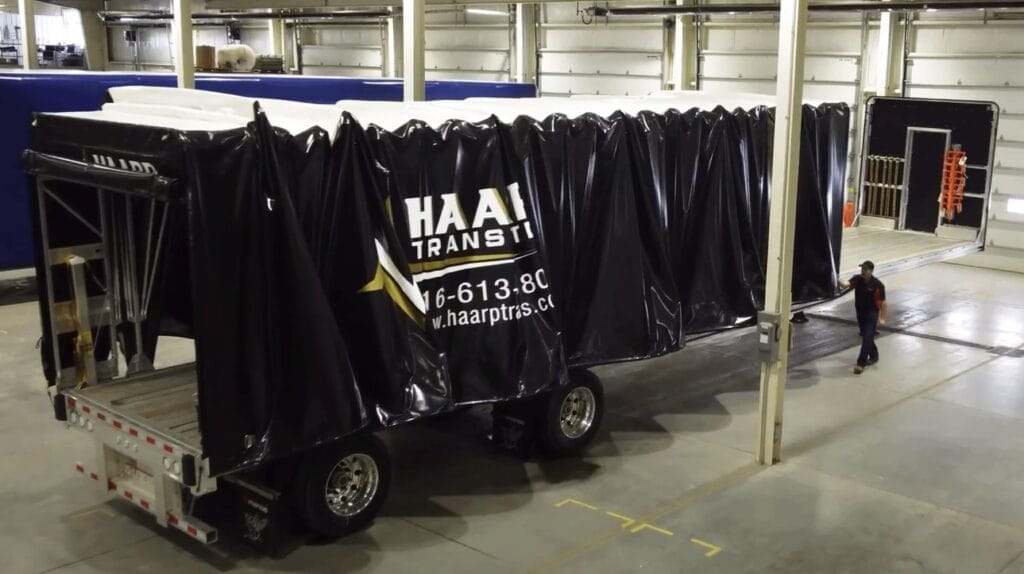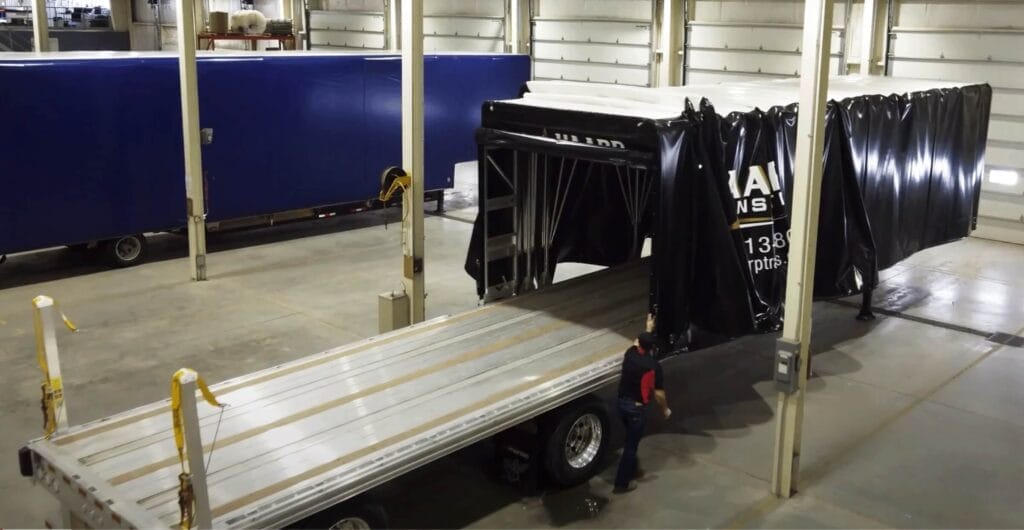When transporting cargo by road, drivers can choose from a number of cargo trailers. Two of the most common trailers on the market today are double drop deck trailers and step deck trailers, also known as step deck Conestoga trailers. Each of these types of trailers has advantages and disadvantages for all shippers and carriers who transport cargo. Here is a comprehensive assessment of double drop trailer vs step deck.
Step Deck Trailer Overview
Step deck trailers are an excellent alternative to flatbed trucks. These trailers are typically 48 or 53 feet long. Most standard step-deck trailers with an upper deck and a low-level rear section can move cargo up to 10 feet 2 inches tall before being classified as oversized.
The flatbed trailer is much shorter than a standard flatbed 5 feet above the ground. It must be at least 3 feet 4 inches long. In the 53-foot form, these trailers’ upper and lower decks are 10 and 43 feet long, respectively, providing sufficient space to haul a range of goods.
These trailers are made to haul cargo that weighs less than 46,000 pounds. Although these trailers can handle open deck cargo like building materials in the same way that flatbed trailers do, they have a unique application for transporting taller cargo. This trailer transports agricultural equipment, crated industrial machines, and other large items.
Double Drop Trailer Overview
Double drop deck trailers, also known as Lowboy, low bed, or float trailers, are closer to the ground than any other trailer style. The double drop trailer dimensions are usually 24 inches above the ground. This is aided by the two drops behind the gooseneck and in front of the rear wheels.
The double drop deck’s overall capacity is limited to cargo space due to the nature of these drops. The height capacity compensates for the double drop’s overall space. Furthermore, the maximum height of cargo transported by these trailer trucks is typically 11 feet 6 inches as long as the trailer is 24 inches or less above the ground.
With a weight limit of 40,000-80,000 pounds depending on the number of axles, the double drop trailer is ideal for heavy transport. Because of its enhanced height capacity, the Lowboy is an excellent choice for carrying heavy equipment such as boxed machines, backhoes, large tractors, and industrial equipment up to 11 feet 6 inches in height or less.
If necessary, the trailers’ upper and rear decks can be used to transport additional goods that do not fit in the 25-30 foot space. Additionally, there are various categories of these trailers: double drop stretch trailers (multi-axle), extendable double drop trailers, low bed hydraulic detachable, etc.

What Are The Pros And Cons Of a Double Drop Trailer vs Step Deck Trailer?
Trucking firms are always looking for new ways to expand and improve their services’ quality. Conestoga trailers are a great example of how this can be accomplished.
Thousands of drivers are learning the benefits of transporting their goods using a Conestoga trailer. And as they save money, meet schedules, and see that the product is in good condition after delivery, their commitment to these trailers deepens.
Let’s go into the pros and cons of a Double Drop Trailer vs Step Deck Trailer (both double drop Conestoga and step deck Conestoga trailer).
(And remember, you can always talk to the experts at Verduyn Tarps to find out which trailer is suitable for your cargo, or see our flexible and secure double drop trailer tarp system here.)
Pros
Offers Protection from Harsh Weather
Conestoga trailers offer truck drivers in this country the most benefit in terms of weather protection. Rain, hail, wind, and snow are frequently unpredictably damaging to goods. Covering the open deck cargo completely with tarps can reduce the possibility of an accident, but this is far from a total solution.
The Conestoga-covered trailer is another good way to prevent confrontation with adverse weather patterns. Before hitting the road, just load the trailer, secure the cargo, and roll in the Conestoga tarp.
Easy Loading and Unloading
Truckers can profit from the advantages of enclosing cargo in a container using the Conestoga trailer. Because this is normally an advantage reserved for dry vans or refrigerated trailers, 360-degree coverage of open deck goods is appealing. Traditional open-deck items cannot be transported in a 53-foot dry container.
The Conestoga-style tarp system can retract and compress to open up the access of your deck. As a result, loading and unloading from the step deck and double drop trailer will still require the use of a forklift, crane, or other mechanical means. If you’re accustomed to loading open trailers, you won’t have to make any changes to your next cargo with Conestoga.
Less Damage Risk
Covering the cargo is a great method to keep it dry and protected from the elements, but it can also harm more delicate items. Because of the nature of tarps, they must be properly secured to the products to avoid wind whip, scraping, and crushing.
Damaged goods help neither shipping companies nor their customers. Fortunately, Conestoga trailers, both double drop Conestoga and step deck Conestoga, which allow you to surround the items without harming them, are an excellent solution to avoid damage while in transit. Traditional throw tarps are sometimes difficult and time-consuming to use. So, utilizing a tarp system makes the work a lot easier.
Cons
Insubstantial Dimensional Capacity
To guarantee that everything runs smoothly and without harm during transportation, all cargo must fit within the dimensional constraints of these trailer covers. Since there is no tolerance for error in such sensitive technology, the Conestoga trailer cannot carry an over-dimensional large load.
To overcome this disadvantage, you can choose to leave the cargo uncovered for those trips and properly secure it with appropriate strapping. Of course, you’d have to do this during good weather.
Limited Weight Capacity
If you wish to put as much weight as possible on such a trailer, you will need to subtract the weight of the tarp system from the total payload. This weight will need to be accounted for when you are considering how heavy of a load you can haul.
However, a retractable tarp system is the among the lightest weighing that you can use to keep your cargo safe yet minimize the weight.
Cost
Shippers who utilize Conestoga trailers find them highly convenient, although they can be costly in areas with limited supply. A number of factors influence transportation industry pricing, the most important of which is supply and demand. Trucking businesses that use these trailers will charge a premium for their services because they are less common than other forms of equipment.
Conclusion
You’re ready to make freight judgments now that you understand the benefits and drawbacks of the double drop trailer vs step deck trailer, as well as why they’re so crucial to the businesses who utilize them. Talk to the experts at Verduyn Tarps to find out which trailer is suitable for your cargo, or see our flexible and secure double drop trailer tarp system here.

